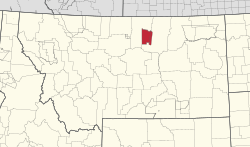Fort Belknap Indian Reservation | |
|---|---|
 River in Fort Belknap Indian Reservation | |
 Location in Montana | |
| Coordinates: 48°12′N 108°36′W / 48.2°N 108.6°W | |
| Tribes | Fort Belknap Indian Community: Assiniboine (Nakoda) Gros Ventre (Aaniiih) |
| Country | United States |
| State | Montana |
| Counties | Blaine Phillips |
| Established | June 1, 1888 |
| Tribal Council | 1904 |
| Headquarters | Fort Belknap Agency |
| Government | |
| • President | Jeffrey Stiffarm Sr. |
| Area | |
| • Total | 1,014.064 sq mi (2,626.41 km2) |
| Population (2017)[2] | |
| • Total | 3,182 |
| • Density | 3.1/sq mi (1.2/km2) |
| Website | ftbelknap.org |

The Fort Belknap Indian Reservation (Gros Ventre: ’ak3ɔ́ɔyɔ́ɔ, lit. 'the fence' or ’ɔ’ɔ́ɔ́ɔ́nííítaan’ɔ, 'Gros Ventre tribe'[3]) is shared by two Native American tribes, the A'aninin (Gros Ventre) and the Nakoda (Assiniboine). The reservation covers 1,014 sq mi (2,630 km2), and is located in north-central Montana. The total area includes the main portion of their homeland and off-reservation trust land. The tribes reported 2,851 enrolled members in 2010. The capital and largest community is Fort Belknap Agency, at the reservation's north end, just south of the city of Harlem, Montana, across the Milk River.
In 2013, the tribes received some bison and have reintroduced them to the local range. In June 2015, the U.S. Department of the Interior sent some 3500 offers to buy back fractionated land worth more than $54 million, affecting the future control of 26,000 tracts of land within the boundaries of the Fort Belknap Indian Reservation. This was under the Land Buy-Back Program for Tribal Nations, established as part of the federal government's 2009 settlement of the landmark Cobell v. Salazar suit over federal mismanagement of revenues due Indian landowners under the trust program.[4][5]
- ^ "Tribal Council Members". Retrieved July 24, 2019.
- ^ 2013-2017 American Community Survey 5-Year Estimates. "My Tribal Area". United States Census Bureau.
{{cite web}}: CS1 maint: numeric names: authors list (link) - ^ Cowell, A.; Taylor, A.; Brockie, T. (2016). "Gros Ventre ethnogeography and place names: A diachronic perspective". Anthropological Linguistics. 58 (2): 132–170. doi:10.1353/anl.2016.0025. S2CID 151520012.
- ^ David Murray, "$54 million offered for tribal land on Fort Belknap Reservation", Great Falls Tribune, 10 June 2015; accessed 18 January 2017
- ^ "DOI sends over $230M in offers to Indian landowners in Montana", Indianz.com, 8 June 2015; accessed 28 October 2016
